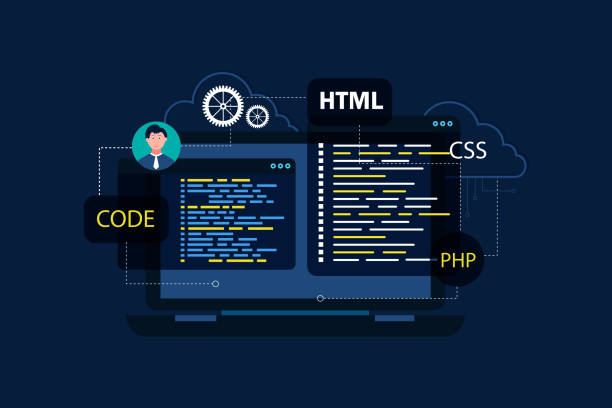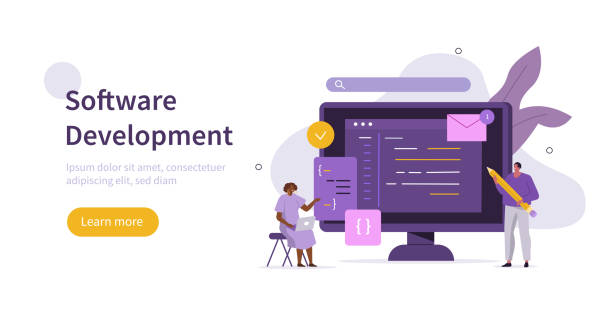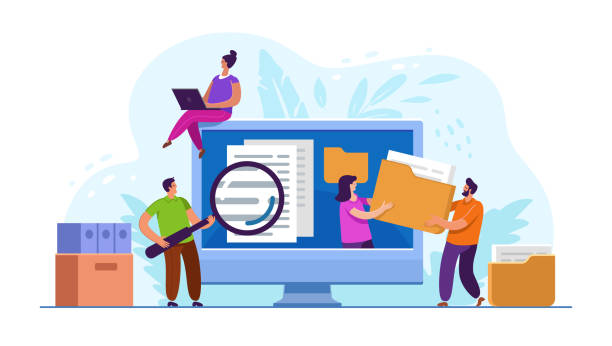The Importance of Secure Website Design in Today’s Digital World

In the current era, where websites have become the lifeblood of businesses and communications, the concept of #Web_Security and #Secure_Website_Design has gained unprecedented importance.
Every day, we witness an increase in the complexity of #Cyber_Attacks and methods of infiltrating online systems, which can cause irreparable damage.
Loss of #User_Data, service disruption, brand reputation damage, and heavy legal penalties are just some of the consequences of ignoring security.
An insecure website not only destroys user trust but can also be a gateway for attackers to access an organization’s internal systems.
Therefore, understanding the importance and implementing the principles of secure website design from the very initial stages of development is an undeniable necessity.
The main goal of secure design is to protect the confidentiality, integrity, and availability of information.
This includes preventing unauthorized access, unintended data modifications, and ensuring the correct and continuous operation of web services.
In this domain, not only programmers and developers but also managers and end-users must have the necessary awareness.
Because a website’s security chain is only as strong as its weakest link.
Investing in secure website design means investing in business sustainability and long-term customer retention.
Ignoring this issue can lead to crises that are far more costly to remedy than to prevent.
Raising public and specialized awareness in this field is the first step towards creating a safer online environment.
This responsibility rests both with developers, who must build secure websites using best practices, and with organizations, who must continuously monitor and update their systems.
Are you dissatisfied with the low sales of your online store?
Rasaweb is your solution for having a professional and high-selling online store.
✅ Significant increase in sales and revenue
✅ Easy and enjoyable shopping experience for customers
⚡ Get free consultation from Rasaweb now!
Common Web Vulnerabilities and Countermeasures

Web security is a complex and evolving topic, and understanding common vulnerabilities is the first step in secure website design.
One of the most well-known and dangerous vulnerabilities is SQL Injection.
This attack occurs when an attacker, by injecting malicious SQL code into website inputs (such as search or login forms), becomes able to manipulate or extract data from the database.
The main solution for countering this threat is the use of Prepared Statements and strict input validation.
Another vulnerability is Cross-Site Scripting (XSS), which allows an attacker to inject malicious client-side scripts into legitimate web pages.
These scripts can steal user cookies, phish sensitive information, or even control the user’s browser.
To prevent XSS, all user-generated outputs must be properly encoded.
Cross-Site Request Forgery (CSRF) is also a common attack where an attacker deceives a user into sending unwanted requests to a trusted website without the user’s awareness.
CSRF tokens and checking the Referer header are among the methods to counter this attack.
Vulnerabilities related to Session Management are also of high importance.
Insecure sessions can lead to Hijacking, where an attacker takes control of a user’s session.
Using HttpOnly and Secure cookies, and limited session lifetimes, prevents these attacks.
Additionally, improper server configuration, weak error management, and lack of software and library updates can also be entry points for attackers.
These issues highlight the necessity of a comprehensive and all-encompassing approach to secure website design.
Fundamental Principles of Secure Website Design

To ensure a secure website design, fundamental principles and best development practices must be followed.
One of these principles is “Input Validation”.
Never trust data received from the user, even if you expect the data to be in a specific format.
All inputs, both client-side and server-side, must be carefully reviewed and validated to prevent the injection of malicious code or unwanted data.
Another principle is “Proper Output Encoding”.
When user-received data is displayed on web pages, it must be properly encoded to prevent XSS attacks.
This ensures that malicious code is displayed as plain text instead of being executed.
The “Principle of Least Privilege” is also crucial.
Grant each user, system, or process only the minimum necessary access to perform its tasks.
This ensures that in case of a breach in one section, the attacker cannot access other parts of the system.
Furthermore, “Secure Error Handling” is very important.
Error messages should not disclose sensitive information or internal system details, as this information can be used by attackers to identify vulnerabilities.
Instead, use general and user-friendly error messages and store detailed information only in server logs.
Developers should always pay special attention to these points to create a robust framework for secure website design.
In summary, here’s a table of the most important fundamental principles of secure website design:
| Principle | Description | Goal |
|---|---|---|
| Input Validation | Thoroughly checking all user-received data before processing. | Preventing attacks such as SQL Injection and XSS. |
| Output Encoding | Encoding data before displaying it in the user’s browser. | Preventing XSS attacks and ensuring correct data display. |
| Least Privilege | Granting the minimum necessary access to each user or process. | Reducing the scope of damage in case of a breach. |
| Secure Error Handling | Not disclosing sensitive information in error messages. | Preventing the disclosure of internal system details to attackers. |
| Secure Session Management | Using HttpOnly/Secure cookies and CSRF tokens. | Protecting user sessions from theft and forgery. |
Backend and Database Security

The backend and database are the heart of a website, and their security is vital for secure website design.
One of the most important measures in this regard is Server Hardening.
This includes installing only essential services, disabling unnecessary ports, configuring firewalls, and regularly updating the operating system and server software.
All default passwords must be changed, and strong, complex passwords should be used.
For secure website design, attention to secure API design is also very important.
APIs must have strong authentication mechanisms (such as OAuth2 or JWT), precise input validation, and Rate Limiting to prevent DDoS attacks and abuse.
Regarding the database, protecting data at rest (Encryption at Rest) and in transit (Encryption in Transit) is a requirement.
The use of SSL/TLS for all database communications is essential.
Also, database access should be limited using the principle of least privilege; meaning each application or user should only have access to the tables and columns necessary for its function.
Using separate user accounts for each service and application that interacts with the database, instead of using a single general account with broad access, is recommended.
Proper access configuration and continuous monitoring of database activities are of high importance.
Detailed logging of all database operations and regular review of these logs help in early detection of suspicious activities.
Regular and secure database backups are also necessary for recovery in case of an attack or system failure.
These collective measures form the backbone of a secure website design.
Don’t have a corporate website yet and missing out on online opportunities? With professional corporate website design by Rasaweb,
✅ Double your business credibility
✅ Attract new customers
⚡ Free consultation for your corporate website!
Ensuring Frontend Security and User Interactions

Although most of the security burden is on the backend, ensuring frontend security is also an integral part of secure website design.
Client-side attacks can disrupt the user experience and even lead to information theft.
One of the most important security measures in the frontend is Content Security Policy (CSP).
CSP is an additional security layer that allows you to define the authorized resources (scripts, stylesheets, images, etc.) that the browser can load.
This helps prevent XSS attacks and code injection, as the browser will only execute resources defined in the CSP.
Client-side Input Validation, while good for user experience, should never be considered the only layer of security.
Attackers can easily bypass client-side validation, so server-side validation must always be performed.
Protection against Clickjacking is also of high importance.
Clickjacking is an attack where an attacker places a transparent layer over a legitimate website, deceiving the user into clicking on something they did not intend to click.
Using HTTP headers such as X-Frame-Options and CSP frame-ancestors can prevent this attack.
Also, for secure website design, secure session management in the frontend should be considered.
Session cookies must be set with HttpOnly and Secure flags to prevent JavaScript access to them and their transmission over insecure channels.
These collective measures ensure that even user-side interactions occur in a secure environment.
Strong Authentication and Authorization

Authentication and Authorization are two fundamental pillars in secure website design that ensure only authorized users have access to the system and only to resources they are entitled to access.
For authentication, secure storage of passwords is of paramount importance.
Passwords should never be stored in plain text.
Instead, strong, one-way hashing functions like bcrypt or Argon2 should be used, employed together with Salt (random string).
Salt prevents dictionary attacks and Rainbow Tables.
Multi-Factor Authentication (MFA) adds a vital security layer.
With MFA, in addition to the password (something you know), the user must also use a second factor such as a code sent to a mobile phone (something you have) or a fingerprint (something you are) for login.
This maintains account security even if the password is stolen.
In the authorization section, Role-Based Access Control (RBAC) is a standard and effective method.
In this model, instead of granting direct access to each user, access rights are defined based on roles (such as administrator, editor, normal user), and users are assigned to these roles.
This makes access management simpler and more secure.
The least necessary access level for each user should always be ensured.
Secure website design, by correctly implementing these mechanisms, prevents unauthorized access and ensures data privacy and security.
Data Encryption and Privacy Protection

Data encryption and user privacy protection are the backbone of a modern secure website design.
All communications between the user’s browser and the website server must be conducted using the HTTPS (HTTP Secure) protocol.
HTTPS, using SSL/TLS, encrypts communications and prevents eavesdropping, tampering, or forgery of information during transmission.
This is a fundamental requirement for any website that exchanges sensitive information, even if it’s just login credentials.
Browsers also flag non-HTTPS websites as insecure, which negatively impacts user experience and SEO.
In addition to encryption in transit, encryption of data at rest (Encryption at Rest) is also vital for sensitive information stored in databases or files.
This helps protect data against unauthorized access even if the server is breached or the hard disk is stolen.
Using strong encryption algorithms like AES-256 with securely managed keys is recommended.
Protecting user data privacy, through the implementation of “Privacy by Design” principles, must be considered from the initial stages of secure website design.
This approach means considering privacy in all aspects of data collection, storage, and processing.
Compliance with data privacy regulations such as GDPR in Europe or CCPA in California has become a global standard, and compliance with them is essential for any website dealing with global users.
In summary, here’s a table of encryption methods and their applications in secure website design:
| Encryption Method | Description | Application in Web Security |
|---|---|---|
| SSL/TLS | Encryption protocols for establishing secure communication between client and server. | Creating secure HTTPS communication, protecting data in transit. |
| Hashing (e.g., bcrypt) | One-way functions for converting data to a fixed, irreversible value. | Secure storage of passwords (with Salt). |
| AES-256 | A strong symmetric encryption algorithm for data encryption. | Encrypting sensitive data in the database (Encryption at Rest). |
| Disk Encryption | Encrypting the entire disk or partitions containing information. | Protecting data against physical disk theft. |
Security Audits and Continuous Updates

Secure website design does not end with the initial development stages; security is a continuous process.
Websites and their underlying software must be continuously reviewed and updated.
Penetration Testing and Vulnerability Scanning are two key tools for identifying weaknesses in a system.
Vulnerability scans can be run automatically and regularly to identify known vulnerabilities, while penetration tests are performed by security professionals with the aim of simulating real attacks to discover more complex and logical vulnerabilities.
One of the most important aspects of maintaining security is regularly updating all components.
This includes the server operating system, web server (such as Apache or Nginx), programming languages (such as PHP, Python, Node.js), frameworks (such as Laravel, Django, React), and all libraries and dependencies used.
Hackers often exploit known vulnerabilities in older software versions to gain unauthorized access.
Therefore, promptly applying security patches released by developers is crucial.
Furthermore, continuous monitoring of server and application logs to identify suspicious activities or attempted intrusions is very important.
Intrusion Detection Systems (IDS) and Intrusion Prevention Systems (IPS) can be helpful in this regard.
The DevOps approach, by integrating security into all stages of the software development lifecycle (DevSecOps), helps organizations make secure website design an integral part of their development culture.
This is a continuous battle, and constant vigilance is necessary to protect the website.
Are you worried about losing customers because you don’t have a professional online store?
With e-commerce website design by Rasaweb, forget these worries!
✅ Significant increase in sales and visitor-to-customer conversion rates
✅ Professional and user-friendly design that builds customer trust
⚡ Get free consultation from Rasaweb
Security Incident Response and Recovery

Even with the best approaches to secure website design, the likelihood of a security incident never reaches zero.
Therefore, having a comprehensive Incident Response Plan is crucial.
This plan should outline the precise steps for handling a security incident, from detection to full recovery.
The first step is incident identification and detection, which usually occurs through monitoring systems, logs, or user reports.
After that, the incident must be contained to prevent its spread.
This may involve isolating infected systems or severing suspicious connections.
The next step is incident root cause analysis to identify the primary cause of the breach and prevent its recurrence.
At this stage, collecting evidence and thorough documentation are important for legal purposes and process improvement.
Then, systems are restored to their operational state before the attack.
This includes restoring data from secure backups, patching vulnerabilities, and bringing services back online.
Having regular and secure backups of all data and configurations is essential for successful recovery.
These backups must be periodically tested to ensure their recoverability.
Finally, after each incident, a Post-Mortem Review should be conducted to identify lessons learned and improve security processes and secure website design.
This review should include evaluating the effectiveness of the incident response plan and identifying weaknesses.
Furthermore, transparent and timely communication with users and relevant authorities in the event of a data breach is of high importance to maintain user trust.
The Future of Web Security and New Challenges

The field of secure website design is constantly evolving in the face of cyber threats.
With technological advancements, attack methods also become more sophisticated, posing new challenges for security professionals.
One of these challenges is the growth of AI-driven attacks, which can make phishing attacks smarter or automatically identify vulnerabilities in code.
Conversely, artificial intelligence can also be used as a tool for cybersecurity defense, for example, in anomaly detection and attack prediction.
Software Supply Chain Security has also become a major concern.
Given websites’ reliance on open-source libraries and components, a vulnerability in one of these components can jeopardize the security of thousands of websites.
Verifying the integrity and security of all dependencies is a fundamental challenge for secure website design.
The emergence of Internet of Things (IoT) and the increasing connectivity of devices to the internet have significantly expanded the attack surface, creating new security challenges for websites interacting with these devices.
The “Zero Trust” model is emerging as a new security paradigm that assumes no user or device, even within the network, can be trusted unless explicitly authenticated and authorized.
This approach can significantly enhance security.
Furthermore, the use of blockchain to improve security, especially in identity management and distributed data, is under consideration.
These advancements and challenges highlight the need for a dynamic and forward-looking approach to secure website design so that websites can remain resilient against emerging threats.
Frequently Asked Questions
| Question | Answer |
|---|---|
| What is secure website design? | Secure website design is the process in which websites are built with security principles in mind to be resilient against cyberattacks and to protect user and business information. |
| Why is secure website design of high importance? | To prevent unauthorized data access, sensitive information leaks, malware attacks, loss of user trust, damage to business reputation, and legal consequences resulting from data breaches. |
| What are the most common website vulnerabilities? | SQL Injection, Cross-Site Scripting (XSS), Cross-Site Request Forgery (CSRF), broken authentication and session management, and sensitive data exposure. |
| How can SQL Injection attacks be prevented? | Using Prepared Statements with Parameterized Queries, Input Validation, and limiting database access. |
| What are the methods to counter XSS (Cross-Site Scripting) attacks? | User Input Validation, Output Encoding before displaying in HTML, and using Content Security Policy (CSP). |
| What is the role of HTTPS in website security? | HTTPS, using an SSL/TLS certificate, encrypts the communication between the user’s browser and the website server, preventing eavesdropping, tampering, or forgery of data. |
| What are the best practices for managing user passwords? | Enforcing strong passwords (a combination of letters, numbers, and symbols), hashing passwords instead of storing them directly (with strong algorithms like bcrypt), and enabling Two-Factor Authentication (2FA). |
| What is the importance of User Input Validation? | Input validation prevents the entry of malicious or unexpected data into the system, which can lead to vulnerabilities such as SQL Injection or XSS. |
| What is the impact of regular security reviews and audits on website security? | These reviews help in the early identification of vulnerabilities and security weaknesses, enabling their remediation before they can be exploited. |
| What is the application of Web Application Firewall (WAF) in secure website design? | A WAF acts as a protective layer between the user and the website, analyzing incoming traffic and identifying and blocking common web attacks like SQL Injection and XSS. |
And other advertising agency services from Rasaweb in the field of advertising
Smart Customer Journey Map: Revolutionize sales increase with precise audience targeting.
Smart Website Development: A specialized service for online growth based on custom programming.
Smart Data Analysis: A combination of creativity and technology for online growth through Google Ads management.
Smart UI/UX: Revolutionize sales increase with marketing automation.
Smart Customer Journey Map: Professional optimization for digital branding using custom programming.
And over a hundred other services in the field of internet advertising, advertising consultation, and organizational solutions
Internet Advertising | Advertising Strategy | Advertorial
Sources
Comprehensive Website Security Guide
Importance of SSL Certificate in Website Security
Important Tips for User Data Protection
Enhancing WordPress Security with Plugins
? At Rasaweb Afarin Digital Marketing Agency, we turn your digital dreams into reality. With our diverse and specialized services, including professional website design, have a powerful and distinct presence in the online world and take your business to its peak.
📍 Tehran, Mirdamad Street, next to Bank Markazi, Kazerun Jonoubi Alley, Ramin Alley, No. 6




